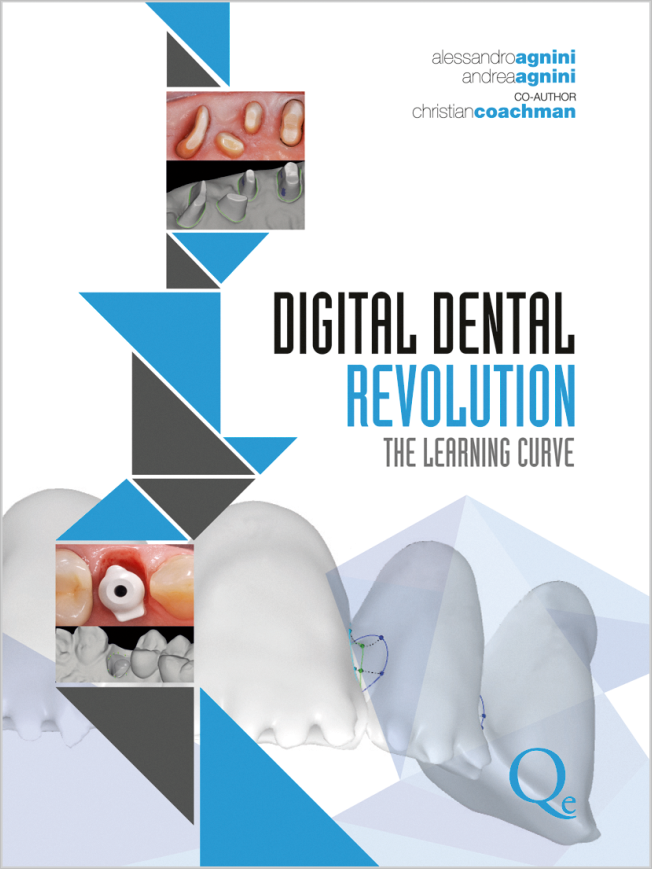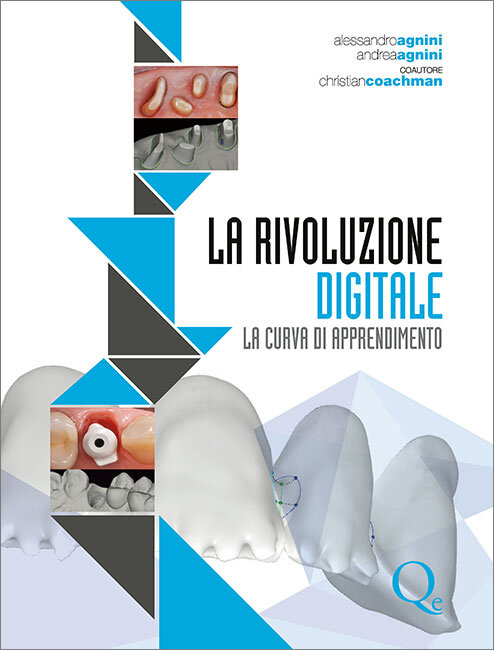International Journal of Esthetic Dentistry (EN), 4/2021
PubMed ID (PMID): 34694081Pages 580-592, Language: EnglishGluckman, Howard / Pontes, Carla Cruvinal / Du Toit, Jonathan / Coachman, Christian / Salama, MauriceBackground: The characteristics of the periodontium in anterior teeth influence the outcomes and prognosis of different periodontal, implant, and restorative procedures. In the present study, CBCT images were used to determine alveolar bone thickness and, to a lesser extent, gingival thickness. The aim was to evaluate the use of CBCT to measure the dentogingival complex in the anterior maxilla.
Materials and methods: CBCT scans from 25 healthy patients were taken and the maxillary anterior teeth (n = 138) analyzed in the radial plane. The study provided descriptive data on gingival thickness, alveolar bone thickness (horizontal measurements), and vertical measurements related to biologic width.
Results: The mean distance from gingival margin to bone crest (BC) was 3.4 ± 0.7 mm, and that between the cementoenamel junction and BC was 2.6 ± 1.0 mm. The average mid-labial gingival thickness 1 mm apical of the gingival margin was 1.0 ± 0.3 mm; a thinner gingiva was observed in females (P = 0.01) and canines (P < 0.001). The average crestal labial bone thickness was 0.8 ± 0.3 mm. In total, 62% of the tooth sites had a thin gingiva (< 1 mm), and 72% had thin labial bone plates; a moderate positive correlation was found between these parameters (P < 0.001).
Conclusions: CBCT was effective in providing data on the thickness of the labial plate and gingiva as well as on the relationship among BC, CEJ, and gingival margin. The majority of tooth sites had thin labial bone and thin gingiva, with thinner gingiva observed in females and at canine sites.
International Journal of Esthetic Dentistry (DE), 4/2021
Pages 510-522, Language: GermanGluckman, Howard / Pontes, Carla Cruvinal / Du Toit, Jonathan / Coachman, Christian / Salama, MauriceHintergrund: Die Eigenschaften des Parodonts der Frontzähne beeinflussen das Ergebnis und die Prognose verschiedener parodontologischer, implantologischer und restaurativer Behandlungsmaßnahmen. In der vorliegenden Studie wurden DVT-Aufnahmen verwendet, um die Alveolarknochendicke und, in geringerem Umfang, die Gingivadicke zu bestimmen. Ziel war es, zu prüfen, ob die digitale Volumentomografie als Möglichkeit für die Vermessung des dentogingivalen Komplexes im Oberkiefer-Frontzahnbereich infrage kommt.
Material und Methode: Von 25 gesunden Patienten wurden DVT-Aufnahmen erstellt und die Oberkiefer- Frontzähne jeweils in der Radialebene analysiert (n = 138). Die Auswertung lieferte deskriptive Daten zur Gingivadicke, (horizontalen) Alveolarknochendicke und biologischen Breite (vertikale Messungen).
Ergebnisse: Der mittlere Abstand vom Gingivarand zum Knochenkamm betrug 3,4 ± 0,7 mm, der Abstand zwischen der Schmelz-Zement-Grenze (SZG) und dem Knochenkamm 2,6 ± 1,0 mm. Die durchschnittliche mediolabiale Gingivadicke 1 mm apikal des Gingivarands lag bei 1,0 ± 0,3 mm. Bei Frauen (p = 0,01) und an Eckzähnen (p < 0,001) war die Gingiva dünner. Die durchschnittliche krestale Knochendicke betrug 0,88 ± 0,3 mm. Insgesamt wiesen 62 % der Zahnstellen eine dünne Gingiva (< 1 mm) und 72 % eine dünne vestibuläre Knochenwand auf. Zwischen diesen Parametern fand sich eine moderate positive Korrelation (p < 0,001).
Schlussfolgerung: Ein DVT kann Daten zur Dicke der labialen Knochenwand und Gingiva sowie zur Lagebeziehung zwischen Knochenkamm, SZG und Gingivarand liefern. Die Mehrzahl der gemessenen Zahnstellen hatte dünnen labialen Knochen und dünne Gingiva, wobei an Eckzähnen und bei Frauen geringere Gingivadicken beobachtet wurden.
International Journal of Esthetic Dentistry (EN), 1/2021
PubMed ID (PMID): 33502130Pages 34-49, Language: EnglishCoachman, Christian / Sesma, Newton / Blatz, Markus B.New digital tools facilitating data acquisition, team communication, computer-assisted diagnostics, and treatment planning as well as the design and fabrication of restorations, guides, stents and devices in general have fundamentally altered key clinical and laboratory steps. The number of new technologies and the amount of new equipment used today to acquire patient data, the software to manipulate this data, and the machines to manufacture devices from it drastically increases all the time, as do the challenges of integrating these systems into a feasible, realistic, and practical workflow. Creating a simple complete digital workflow is key to taking advantage of these digital opportunities and offering their benefits to all patients. Making digital workflows the routine rather than the exception is fundamentally important in order to grow a dental practice in this new environment. This article presents a new complete digital workflow that changes and improves the process of treating a comprehensive case from diagnostics to execution and maintenance.
International Journal of Esthetic Dentistry (DE), 1/2021
Pages 34-50, Language: GermanCoachman, Christian / Sesma, Newton / Blatz, Markus B.Neue digitale Möglichkeiten für die Datenakquise, Kommunikation im Team, computergestützte Diagnostik und Behandlungsplanung sowie Design und Herstellung von Restaurationen, Schablonen, Schienen und Apparaturen im Allgemeinen haben zu grundlegenden Veränderungen bei den zentralen klinischen und zahntechnischen Arbeitsschritten geführt. Täglich erhöht sich die Anzahl neuer Techniken und Geräte, die mittlerweile für die Erhebung von Patientendaten eingesetzt werden. Es gibt stetig neue Software für die Verarbeitung dieser Daten und es entstehen neue Geräte, die anhand dieser Daten Restaurationen und Apparaturen herstellen. Damit wachsen jedoch auch die Herausforderungen, diese Systeme in sinnvolle, realistische und praktikable Arbeitsabläufe einzubinden. Die Etablierung eines einfachen volldigitalen Workflows ist der Schlüssel dazu, die digitalen Möglichkeiten sinnvoll und zum Vorteil der Patienten einzusetzen. Um eine Zahnarztpraxis vor diesem neuen Hintergrund erfolgreich zu führen, müssen digitale Workflows von der Ausnahme zur Regel gemacht werden. In diesem Artikel wird ein neuer volldigitaler Workflow vorgestellt, um das Management komplexer Fälle von der Diagnostik über die Behandlung bis zur Nachsorge zu verändern und verbessern.
International Journal of Computerized Dentistry, 3/2020
ApplicationPubMed ID (PMID): 32789313Pages 257-267, Language: German, EnglishParis, Marion / Nurdin, Nathalie / Manzano, Guillermo / Caroleo, Francesca / Messaoudi, Yassine / Bischof, Mark / Nedir, Rabah / Coachman, ChristianAim: Surgically facilitated orthodontic treatment is increasingly being used, especially for adults, to facilitate tooth movements and reduce the duration of orthodontic treatment. The present article reports on an innovative, safe, and minimally invasive technique to perform flapless corticotomies using a dedicated surgical guide produced with a complete digital intraoral and laboratory workflow.
Materials and methods: A 51-year-old man presented with maxillary and mandibular anterior crowding. He required rapid treatment with limited use of braces. Corticotomies were planned for both arches before the use of orthodontic appliances. The matching of the stereolithographic files obtained from the digital prints of the full arches and the cone beam computed tomography images allowed for the positioning of the cutting planes for corticisions. The guide was printed with a transparent, biocompatible, and photopolymerizable resin, and cold sterilized. Minimally invasive corticotomies were performed using a piezoelectric instrument. The orthodontic treatment started immediately after surgery.
Results: No adverse events were recorded during surgery. The piezoelectric instrument was guided accurately, and precise application of the corticisions prevented all the anatomical elements from being injured. The healing was uneventful and the patient experienced no pain.
Conclusion: The present report shows that a surgical guide specifically and digitally produced for corticotomies allowed for the performance of a minimally invasive flapless technique and accurate piezosurgery. The use of such a guide was easy to implement, made the procedure safer, and reduced postoperative pain.
Keywords: guided surgery, corticotomies, surgical guide, computer-aided design, surgically facilitated orthodontic treatment, piezoelectric surgery
International Journal of Esthetic Dentistry (DE), 2/2019
Pages 176-192, Language: GermanCalamita, Marcelo / Coachman, Christian / Sesma, Newton / Kois, JohnDie Veränderung der vertikalen Dimension (VD) ist eines der kontroversesten Probleme der restaurativen Zahnmedizin. Eine Veränderung der VD kann indiziert sein, wenn die dentofaziale Ästhetik verbessert, Platz für geplante Restaurationen geschaffen und die Okklusionsbeziehung optimiert werden muss. Die VD sollte nicht als unveränderliche Referenzgröße betrachtet werden, sondern als dynamisches Maß innerhalb eines physiologischen Toleranzbereichs, das verändert werden kann, solange der Zahnarzt den funktionellen Rahmen beachtet. Allerdings haben Veränderungen der vertikalen Beziehung zwischen Unter- und Oberkiefer gewisse biologische, biomechanische, ästhetische und räumlich-funktionelle Auswirkungen, da die ursprünglichen Referenzen der maximalen Interkuspidation und Frontzahnbeziehung räumlich auf einer neuen Höhe rekonstruiert und angepasst werden müssen. Ziele dieses Artikels sind ein Review der relevanten Literatur zur VD und die Formulierung klinischer Ziele und subjektiver Parameter, die den Zahnarzt und Zahntechniker bei Behandlungen mit Veränderung der VD leiten können.
International Journal of Esthetic Dentistry (EN), 2/2019
PubMed ID (PMID): 31061997Pages 166-181, Language: EnglishCalamita, Marcelo / Coachman, Christian / Sesma, Newton / Kois, JohnChanging the occlusal vertical dimension (OVD) has been one of the most controversial issues of restorative dentistry. The modification of the OVD may be indicated whenever it is necessary to harmonize dentofacial esthetics, provide space for planned restorations, and improve occlusal relationships. The OVD should not be considered an immutable reference, but rather a dynamic dimension within a zone of physiological tolerance that can be altered as long as the dentist respects the envelope of function. However, vertical changes in the relationship between the maxilla and mandible may have some biological, biomechanical, esthetic, and three-dimensional (3D) functional implications because the initial references of maximum intercuspation and anterior tooth relationships must be reconstructed and adjusted in a new dimension of space. This article aims to present a critical review of the relevant OVD literature and provide the clinical objectives and subjective parameters necessary to guide the clinician and laboratory technician during treatment involving OVD alterations.
International Journal of Periodontics & Restorative Dentistry, 2/2017
DOI: 10.11607/prd.2911, PubMed ID (PMID): 28196157Pages 182-193, Language: EnglishCoachman, Christian / Calamita, Marcelo Alexandre / Sesma, NewtonMedical and dental histories, clinical examination, study models, and photographs provide the data for a proper diagnosis and the treatment plan for esthetic dentistry. However, they do not offer all the information necessary to analyze the smile and create harmony with the lips and face without excessive intraoral adjustments. Dentolabial parameters vary according to lip dynamics and are influenced by both a static posed smile and a smile in motion as captured in video. This article describes a documentation protocol using smartphone videos to improve the analysis, smile design decisions, and elaboration of a 2D smile frame that will guide the 3D digital smile design project. The use of dynamic documentation of the smile (DDS) allows esthetic rehabilitative planning from a facial perspective, improvement of communication with the patient, integration between the specialists, and the predictable quality of the treatments.
QZ - Quintessenz Zahntechnik, 3/2016
BasicsPages 360-371, Language: GermanAgnini, Alessandro / Coachman, Christian / Chu, Stephen J. / Agnini, AndreaFür eine über 4 Jahre nachverfolgte ästhetische Versorgung wurde das Digital Smile Design (DSD) verwendet. Das DSD dient zur Unterstützung der Diagnose, Verbesserung der Kommunikation und Erhöhung der Vorhersehbarkeit des Behandlungserfolgs. Dazu erfolgte eine ästhetische Analyse von Gesicht, Lächeln, Parodont und Zähnen. Bei der Kasuistik wurde ein Protokoll umgesetzt, bei dem ästhetische Sonden (Chu Gauges Proportions-Set) eingesetzt wurden, um die richtige Position der Hartgewebe objektiv zu bestimmen und einen zuverlässigen ästhetischen Erfolg der Behandlung zu ermöglichen.
Keywords: Smile Designer, Digital Smile Design, Zahnproportionen, interdisziplinäre Behandlungsplanung, Chu Gauges Ästhetik-Set
QZ - Quintessenz Zahntechnik, 7/2014
BasicsPages 822-833, Language: GermanCoachman, Christian / Calamita, MarceloWerkzeug zur Therapieplanung und Kommunikation in der ästhetischen ZahnheilkundeDie Autoren stellen das "Digital Smile Design" vor, ein Werkzeug zur Therapieplanung und Kommunikation in der ästhetischen Zahnheilkunde. Es dient über den gesamten Verlauf einer restaurativen Behandlung zur Unterstützung des Behandlungsteams, fördert das Verständnis von Team und Patient für ästhetische Defizite und verbessert die Zufriedenheit des Patienten mit dem Ergebnis der Behandlung. Mithilfe der Möglichkeit, extra- und intraorale Digitalfotos mit Referenzlinien und anderen Formen zu versehen, wird die diagnostische Visualisierung auf eine breitere Basis gestellt. Einschränkungen, Risikofaktoren und ästhetische Kriterien von individuellen Behandlungsfällen lassen sich so besser beurteilen.
Keywords: Ästhetik, Digital Smile Design, Therapieplanung, Kommunikation, interdisziplinäre Zusammenarbeit





